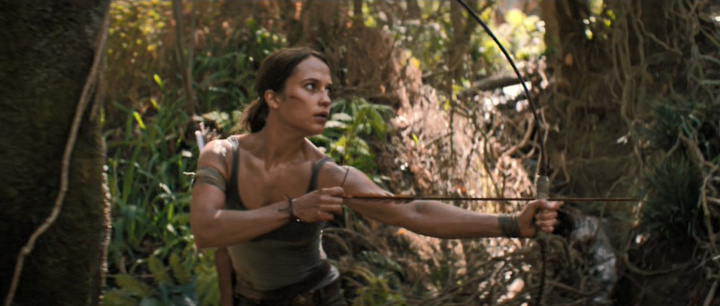
Weirdly, I really like this interpretation of Lara Croft even though it’s radically different from the James Bond meets Indiana Jones original and even though it’s based on (but mercifully different from) the whiney, forever-out-of-breath, frightened little girl from the 2013 video game reboot.
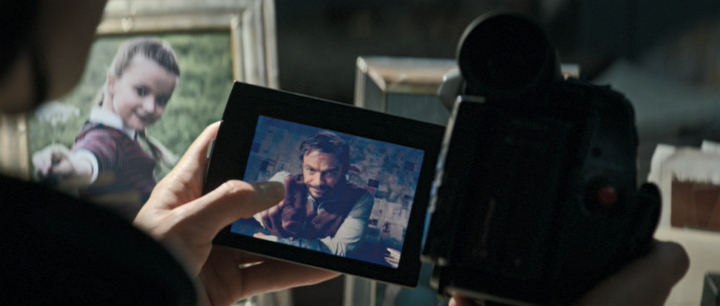
I love this shot of Richard Croft’s message to his daughter, framed by the black plastic surrounding the LCD screen, held at a slight angle with a framed picture of young Lara to the left which, itself, is next to the over-the-shoulder silhouette of adult Lara which provides counter-weight to the large black mass of the camera’s body.
Review by Jay Wilson What I find fascinating about Tomb Raider (2018) is that while I thoroughly enjoy the movie as a whole, every time I watch it, I cringe at a very specific part. The film tells the tale of a young Lara Croft searching for her missing father who vanished seven years prior pursuing the lost resting place of a forgotten Japanese empress. After a clue drops into her lap that leads her to her father’s secret research, she retraces his steps to an uninhabited island in Japan where she comes face to face with the man, Mathias Vogel, who supposedly murdered Richard Croft. And after seven years, Vogel and his crew still search the same island seeking the lost tomb of Empress Himiko. Lara escapes, gets swept down the river, a tracker goes after her, and after she wakes up in the middle of the night and kills said tracker, she finds her father by literally just glancing up. There’s coincidence, and then there’s bullshit. This is bullshit. If in seven years—two-thousand-five-hundred-fifty-six-and-three-quarter days—if in all that time you and an entire team of experienced searchers with corporate backing and regular air drops plus de facto slaves fail to find one stone door with a surface area in excess of four-hundred feet, a door that does not move, and you’re actively searching for said door, you’re not going to accidentally stumble across a 5’6” woman who moves around while trying to stay hidden, and you’re sure as hell not going to do it on the very first day when you don’t even know she’s within a thousand miles to even bother looking for her. I have a hard time believing Richard Croft has survived on scavenging alone while actively sabotaging the bad guys without being noticed for seven years. I have a harder time believing the bad guys have neither found the thirty-foot semi-circular door nor given up and moved on to another island in seven years. And I absolutely cannot believe Lara basically trips and falls into her father’s lap completely by chance in only a couple hours. And here’s the part that makes it fascinating: I like that Richard Croft is in the movie. Let’s forget about his, frankly, impossible introduction and focus purely on the character and his associated arc. Dominic West gives a charming performance as Richard Croft; he’s warm and charismatic while simultaneously bound to a greater sense of duty. I like the conflict that arises between the elder Croft and his daughter where Richard believes the legends of Himiko and will do anything to protect the world from her curse while skeptical Lara just wants to go home and enjoy having a father again. And I love that in the final act, it’s the disbelieving Lara who figures out that her father is both right and wrong—that Himiko does, indeed, carry a globe-threatening curse, but not the supernatural kind found in ancient mythology. Hers is a naturally occurring curse, one that the ancients did not understand and chalked up to the blanket explanation: magic. Lara’s revelation humbles Richard who should have known better than to immediately jump to fantastical explanations, and at the same time the revelation inspires Lara to stand with her “crazy” father, united in their resolve to keep Himiko out of Mathias Vogel’s and his employer’s hands. This gives Richard a noble and satisfying departure as he sacrifices himself for the greater good, it gives Lara a chance to bid him a proper farewell, but more importantly: it gives Lara a suitably badass moment where she becomes the tomb raider, telling the antagonist, “You’re not getting out of here” as she kicks the makeshift bridge into the chasm behind her, wordlessly declaring that she’s willing to die to stop him. 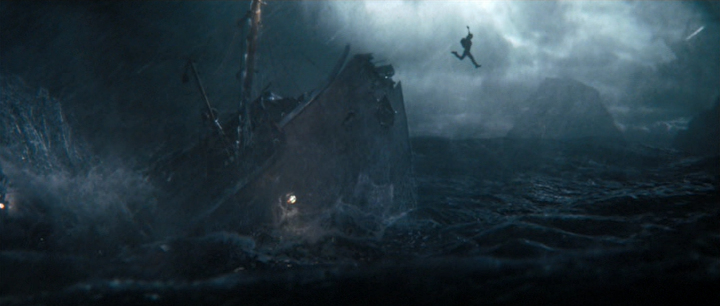
Gameplay-wise, starting on the island is more interesting in a classically Tomb Raider way than running around London, getting into trouble GTA style, and cinematically-speaking, developing Lara makes sense before sending her on an adventure.

Lara does lots of running, jumping, climbing, swinging from ropes, and hanging from precipices, but the action never gets old because each sequence has its own setting and naturally occurring obstacles.

Many elements from the 2013 game superficially find their way into the movie with new context such as the name of the ship, the cursed island and its storms, Himiko, a villain named Mathias, the crumbling WWII bomber, parachuting through the trees, and Lara getting impaled in the side of her lower abdomen (among others).
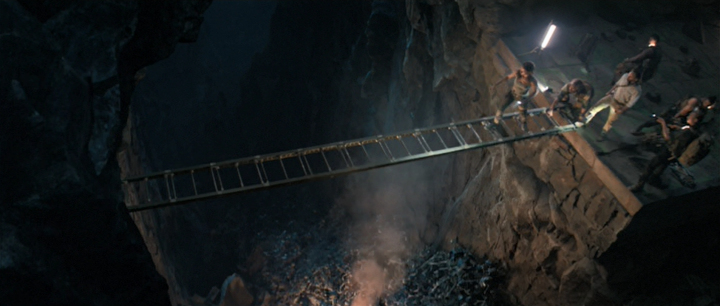
Naturally the tomb raider has to end up in a tomb at some point. Notice how the concerned father crouches down to hold the ladder in place to the best of his ability while the callused tyrant just steps on it, uncaring as to whether Lara succeeds or fails.
I like to say that characters are the gateways to the story. You experience the narrative through them, and I find that I can forgive even epic plot missteps if I like the characters. And I like Richard. I like Lara. And I even like Mathias Vogel. The writers and actor Walter Goggins breath refreshing life into the antagonist, who partly reminds me of a prison-warden type character—a once aspiring young man with grand ambitions relegated to a miserable dead-end position as punishment for stepping on the wrong toes. Vogel has absolute power and reigns over this island with an iron first, but in the grand scheme of things he’s a low-level manager at best, and he not only knows it, but hates it. Maybe once upon a time he killed for the sadistic satisfaction of inflicting misery on other human beings, maybe once he actually had compassion—who knows—but now he just wants to get off this god damn island, and if he has to hurt, kill, rape, or pillage to do it, so be it. And at the same time the isolation has taken its toll on him. In his first scene with Lara, he attempts basic hospitality, but the look in his eyes are so distant and his words are so detached, he might as well be talking to himself. He doesn’t know what to do, so he wanders around the tent like a puppet going from point to point in a hollow imitation of life, and likewise his conversation wanders from topic to topic as his thoughts drift aimlessly with no segue or cohesion. And this borderline insanity gives him a nice little sliver of sympathy because while he’s still a bad guy—a very bad guy—he’s also a victim of a bad deal. Daniel Wu gets a thankless role as Lu Ren who serves a vital purpose, transporting Lara to the island (as his father transported Richard Croft seven years prior and disappeared as well); however, despite being a likeable character who reluctantly gives up his alcoholic depression and gains a new sense of purpose through Lara’s quest, Lu Ren really doesn’t have a logical opportunity to do much else. And while I do wish he had more to do, I appreciate that the filmmakers recognized his role and separated him from Lara on the island; with Richard Croft unnaturally showing up out of nowhere, had the story unnaturally tried to shoehorn Lu Ren into the tomb raiding third act, it probably would have pushed me all the way into suspension of disbelief. He does help Lara with her initial escape, and I would have been satisfied to see Mathias kill him off as that would be completely within Vogel’s character. However, he survives and later on helps liberate the rest of the workers when Lara briefly returns, but after that he spends the rest of the film mostly offscreen, waiting in the woods while Lara, Richard, and Mathias descend into the tomb of Himiko. A bummer, but I respect not keeping a character in the story when there’s no logical reason to keep him in the story. Finally, Lara Croft, herself. I think what I like most about Tomb Raider (2018) is that Lara Croft gets the crap beaten out of her. That sounds like I hate the character (or the actress, Alicia Vikander), but I don’t. I’ve liked Lara and Tomb Raider since the first PlayStation game way back in 1996, and I really like this interpretation of her. Alicia Vikander is not physically imposing. She looks small and feeble up against the villains and especially compared to the raging elements. She looks like she should get knocked down over and over and over again, and she does. But I like a vulnerable Lara. Even the most badass macho hero needs some degree of vulnerability. That’s why The Predator beats the tar out of Arnold Schwarzenegger. That’s why Bruce Willis barely limps away from the Nakatomi building. And that’s why Superman has kryptonite. The action sequences in Tomb Raider (2018) have more meaning than, say, the action sequences in Lara Croft: Tomb Raider (2001) because Alicia Vikander plays an actual character and not an icon who is just too cool for the gunfire and explosions around her. Vulnerability is what makes Lara sympathetic and relatable. What makes her heroic and inspiring is that after mother nature bitch-slaps her to the ground for the fifth time, she still gets back up. 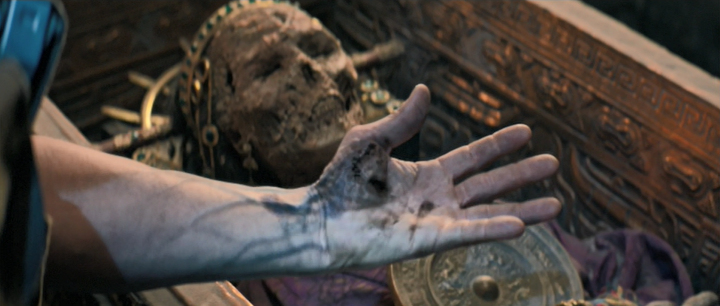
Granted, Himiko’s plague is unrealistically (maybe even supernaturally) lethal in how it kills in a matter of seconds. I thought the misunderstood disease angle was much more clever than the game’s overt soul-stealing-to-live-forever finale.
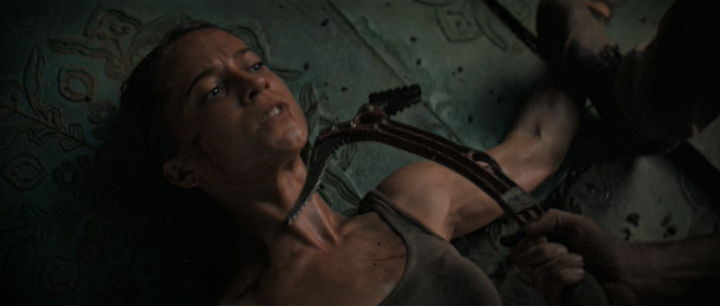
The climber’s axe is perhaps the coolest addition to the Tomb Raider series in a long, long time. It’s nice that it’s featured so prominently in the final battle.
And notice I didn’t say vulnerability makes the action realistic. Lara survives things she has no business surviving (just as all action heroes survive situations that would unquestionably deliver fatal injuries). But by having debris stab Ms. Croft after falling from an impossible height through a thick forest canopy, it puts the ridiculous set piece within the realm of acceptable suspension of disbelief. Lara crashes, burns, rolls a few hundred feet, and gets hurt—she should absolutely be dead—but having her deal with a stick impaling her abdomen is all you need. It at least pretends like Lara might be killed (She won’t. We know she won’t. But it’s nice when the protagonist at least struggles with something every now and again.) It also makes the action more entertaining because the world falling apart is inherently funny since everyone has had one of those days. You know the ones I’m talking about. You drop your toast at the breakfast table, you pull a muscle trying to reach it, you bang your head on the way up, then you knock your orange juice over reaching for the salt ... and then the shaker lid comes off and spills salt all over your food. Then you find yourself looking up and asking, “Anything else? Let’s just get it all out of the way right now.” That humor injects a necessary release to the wall-to-wall tension, keeping the action from becoming monotonous—it’s one of the reasons Raiders of the Lost Ark is a classic. And there’s a great Indiana Jones inspired moment when Lara escapes from Mathias’ prison camp, falls into river rapids, barely avoids going over a waterfall, then barely avoids falling again when the bomber wing she’s standing on starts to crumble, and just when she thinks she has a moment’s reprieve, the rest of the plane starts to go over the waterfall with her inside. She looks up at the creaking fuselage and says, “Really?” providing the perfect release at the perfect moment. Again, it does not make her situation more realistic (if anything it makes it more silly); however, realistic is not the same as believable. Believing is something you choose to do, and it’s something you can do even in spite of overwhelming evidence to the contrary (see literally any modern political discourse, for example.) 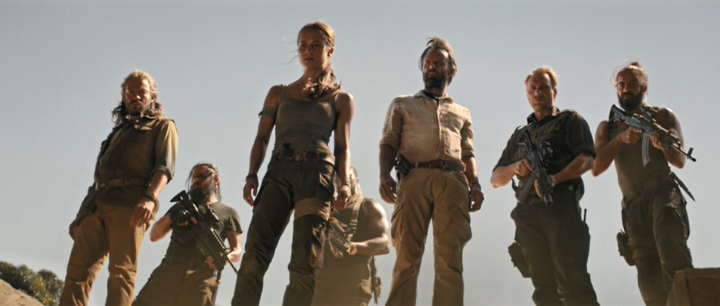
It’s interesting that in regards to Himiko, Lara has more in common with the villain than her own father. Richard Croft actually cares about what awaits them inside; meanwhile, both Mathias and Lara just want to get the hell off the island and go home.
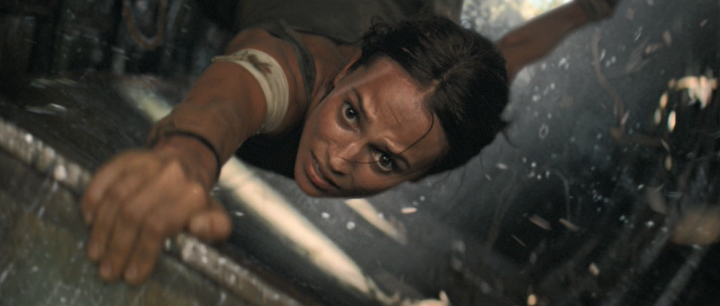
This right here is why Tomb Raider (2018) is one of my favorite recent movies. Action has to be bigger than the main character, and that’s been lost in the last decade of cinema. I love that Lara spends the second half of the movie just barely holding on.
What surprised me the most, however, is that Lara begins the film as a failure. She gets choked out in the opening sparring scene, she crashes her bike into a cop car during an illegal race. We know she’s going to succeed in the end, but seeing her fail—and fail repeatedly—makes those inevitable successes that much more satisfying because she’s actually getting better; she’s learning. She’s completing an arc. I also like that Lara starts out with a real-world job and has to participate in illegal races to pay her gym membership, and I like the movie even more when they found a way to reconcile this Lara with the spoiled rich girl from the video games: yes, she has an inheritance, but she refuses to accept it because she refuses to accept that her father is dead. Voluntary poverty? That’s integrity. Stubbornness too, and maybe a bit of stupidity, but how many people do you know who will pass up free money for any reason? I also feel that this more believably sets her up to become the adventure-seeking tomb raider we all know versus a pampered rich girl who never had to work for anything. And like any good trait, Lara’s stubbornness is a double-edged sword. Yes, it pushes her to not relent and stand by her beliefs no matter what, but the key to finding Richard only drops in her lap when she finally relents and agrees to sign the paperwork granting her her inheritance (which she only does because she has no choice). So, she literally could have found Richard years sooner had she signed the papers way back when. Plus one could argue she didn’t think it through because why not accept the inheritance, use her family’s incredible resources to conduct a world-wide search, and if she does find her father, she could always transfer the assets back to him. Deals are made all the time. It’s not like ownership is permanent. But I don’t fault the film for that. For one, it’s one of those amusing little nitpicks that really doesn’t detract from the overall package, and for two, it’s actually both realistic and believable. People fail to think things through all the time, almost always because they stubbornly cling to an often-times irrational belief. People forever plant their flag and metaphorically die on a hill that doesn’t make any logical sense—something else for Lara to take a lesson from. By the end, Lara Croft has a better understanding of where and when to fight her battles, so I can accept a stupid illogical decision made in her youth. I can’t, however, accept that Richard Croft pops up out of nowhere because that just defies raw mathematical probability. | ||||||||||||||||||||
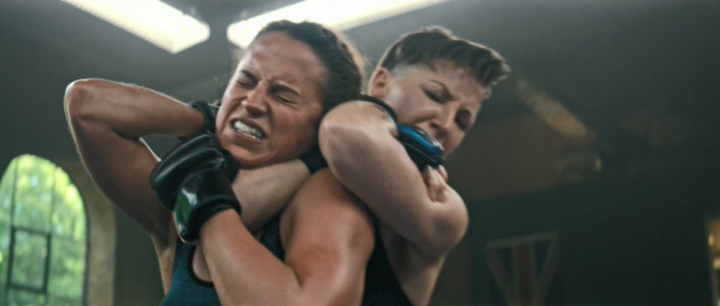



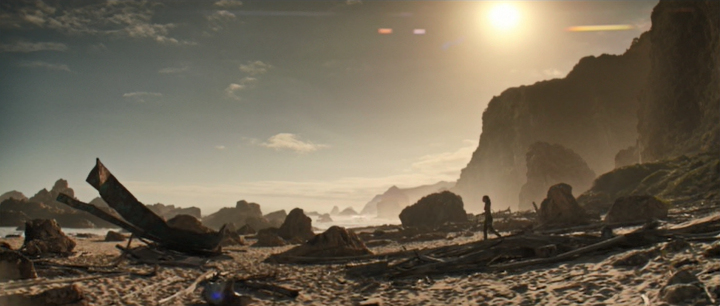 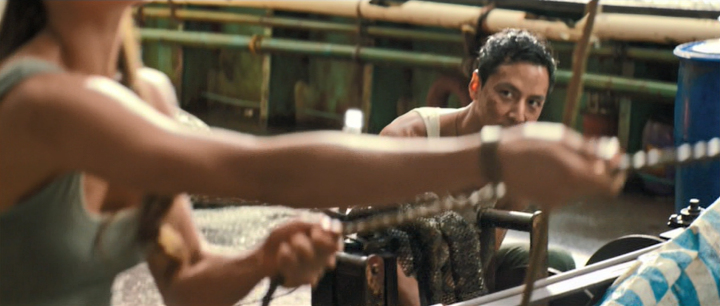

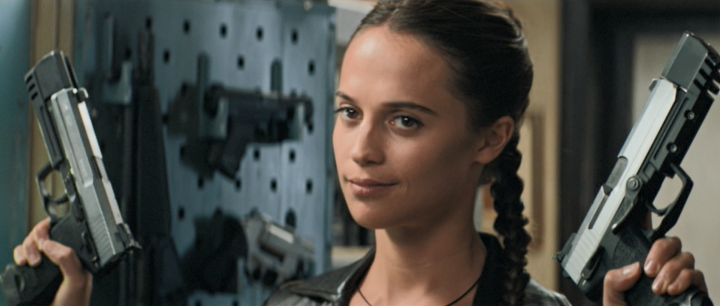
| ||||||||||||||||||||
|
| ||||||||||||||||||||
